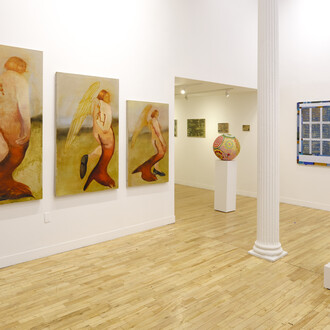Jack Barrett is pleased to present Les vagues, a solo exhibition of new work by Montreal-based artist Élise Lafontaine. This marks the artist’s first solo exhibition with the gallery, as well as her first exhibition in New York City. Translated from French, the title means the waves, referencing the structural wave of her volumetric canvases and the organic forms painted on said surfaces. Les Vagues can also be interpreted as something difficult to grasp or decipher: to be vague, to have something on the tip of your tongue. This is an uncomfortable place for most, but not for Lafontaine.
Just as certain words have the feeling of roundness in your mouth, Lafontaine’s paintings are soft and bulbous. Canvases morph towards the viewer, physically built up into sculptural paintings. Depending on the angle of viewing, and especially in photographs, the shape of the canvas is imperceptible. Both the 2D and 3D paintings require the eyes to work to understand depth perception and movement. Look closely at Lafontaine’s paintings, and you’ll uncover layers of colours that, when viewed together, morph into a cohesive composition.
The paintings aren’t of a singular concept but a culmination of ideas and experiences condensed into one plane. Lafontaine’s source materials come from her experience of visiting the Lombrives Cave and Le Corbusier's Ronchamp Chapel in France, and The Goetheanum in Switzerland. Through photographs, as well as memories, Lafontaine departs from these sources to create a feeling of space. They represent something outside of our grasp, as if viewing the world from inside a wave or through a heavy fog.
Lafontaine’s paintings are distortions of everyday shapes that resemble the body and architecture with anthropomorphic qualities, creating an indeterminate sense of knowing without the ability to qualify. The artist morphs an image through collage, rendering the source material unrecognizable by physically cutting canvases after they’ve been painted and stitching them to assemble a new composition. Through rigorous research and experimentation, Lafontaine abstracts reality. Sometimes, only a slight shift of perspective or a 60-degree turn renders a familiar scene unrecognizable. By distorting reality, Lafontaine creates a new way to view the world.
Where we desire specificity; Lafontaine offers an alternative path. The exhibition suggests existing within the uneasy space before meaning is made. The feeling is akin to recognizing a friend’s gait from blocks away, but also the opposite encounter of mistakenly waving to someone who ends up being a stranger. We live so much of our lives in this space of vagueness that edges on certainty— Lafontaine captures it with precision.
(Text by Tatum Dooley)
















